Recipes
26 August 2021
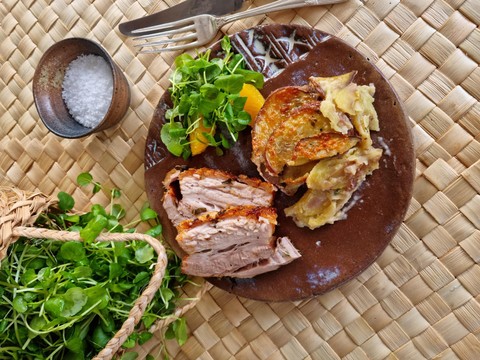
*2 tbsp butter
*100ml milk
*300ml cream
*1 bay leaf
*salt & black pepper
*1.5kg red-skinned kumara
*2 pinches horopito pepper (or thyme leaves)
*50g parmesan cheese
Preheat the oven to 200°C. Butter a deep ovenproof dish, around 25 cm x 20cm.
Bring the milk, cream and bay leaf to the boil in a saucepan. Leave on a very gentle simmer for 2 to 3 minutes, then remove from heat and season with salt and pepper.
Finely slice the kumara and layer this in the gratin dish in neat layers. Cover with the hot cream and horopito and shake gently to distribute the liquid. Sprinkle the top with parmesan, cover with tinfoil and bake for 50 minutes or until the kumara are tender when a skewer is pushed into them.
(Tip. It is a good idea to put a tray under the dish as it cooks as the cream can bubble up and spill over.)
For the crisp roasted pork belly
*800g piece of pork belly with skin attached and scored
*2 tbsp fennel seeds
*1 tsp salt
*Freshly ground black pepper
*2 lemons
* 2 cloves garlic
* 1/2 tsp salt
* 1/2 tsp freshly ground black pepper
* 8 sage leaves
* ½ cup white wine
Score the surface of the pork belly skin with a very sharp knife or a clean Stanley knife.
Pound the fennel seeds, salt, and pepper together with a mortar and pestle or in a spice processor until finely ground. Rub this mixture well over the pork surface and the skin. Crush the garlic and sprinkle this over the pork with the grated zest of the lemons and the sage leaves. Leave, covered so the flavours to permeate the meat for at least two hours or overnight in the refrigerator.
Heat the oven to 220˚C and place the pork in a roasting pan with the scored fat sitting upwards. Cook for 15 minutes then reduce the oven temperature to 160˚C and continue cooking for another 60 minutes.
Take the pork from the oven, place on a carving dish and cover with foil. To make a sauce, deglaze the pan with the wine and the juice of one of the lemons and bring to a simmer. Continue to simmer, reducing by half. Strain this sauce, season to taste.
Print • ∞ Permalink • Comments
26 December 2020
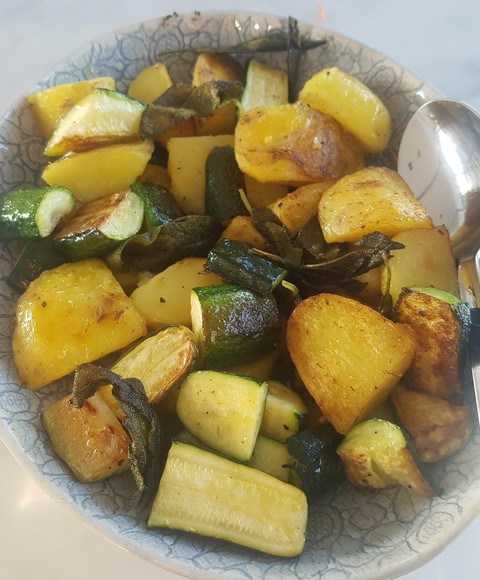
Inspired by my garden (courgettes and sage) and the local freshly dug Agria spuds
- 3 new large new potatoes (Agria)
- 3 courgettes, freshly picked
- A handful of sage leaves, freshly plucked
- 3 tbsp olive oil
- Sea salt and freshly ground black pepper
Scrub the potatoes and cut into bite sized pieces. Place in a steamer over boiling water and allow to steam until just cooked.
Cut the courgettes into similar size pieces to the potato. Heat the oil in a large frying pan, add the courgettes and cook over medium heat for 2 minutes to brown lightly.
Lower the heat and add the steamed potato pieces with the sage leaves and plenty of salt and pepper to the courgettes. Continue to cook over low heat for about 15 to 20 minutes until the potatoes and golden and a little crunchy.
Serve at once. Serves 4
Print • ∞ Permalink • Comments
21 June 2020
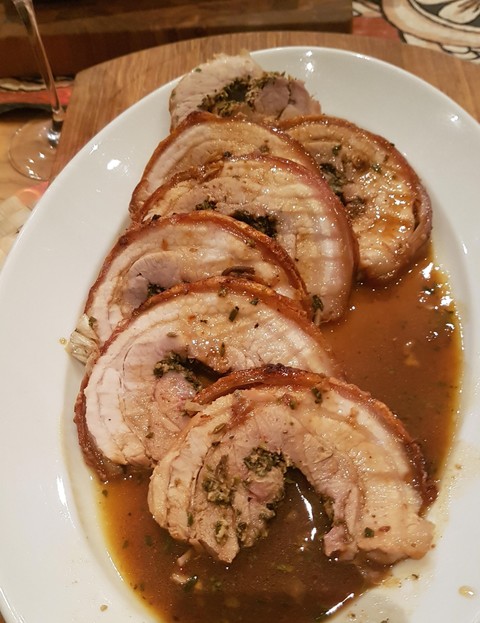
You only need a small serving of this rich delicious meat and there will be lots of leftovers for lunches and other meals. The trick is to try to get a crisp, crunchy crackling on the pork. The anchovies can be left out - just use a little more salt - and any other of your favourite herbs and spices can substitute for the sage, rosemary and chilli.
- 1.5kg pork belly
- 2 cloves garlic
- 1 tsp sea salt
- 1 tsp freshly ground black pepper
- 3 tsp fennel seeds
- 12 anchovies, chopped
- 8 fresh sage leaves, roughly chopped
- 1 sprig fresh rosemary leaves
- Pinch of chilli flakes
- 1 lemon, zest only
- 1 tbsp olive oil
- 1 red onion
1 cup water
Lay the pork belly skin side up and with a very sharp heavy knife, score the surface in straight lines.
Crush the garlic with the sea salt, place in a bowl and add the fennel seeds and ground pepper, with the sage leaves and chopped anchovies. Mix well together. Add rosemary, lemon zest and olive oil.
Put the fat/skin side down and smother the surface of the meat over the pork.
Roll the belly up, and tie it tightly closed with cotton string, making sure the stuffing is not oozing out anywhere. Rub a little extra olive oil and salt and pepper over the rolled pork. You can prepare the recipe to this point and refrigerate until you want to roast it.
Preheat the oven to 200°C. Cut the onion into wedges and sit the pork on top in a shallow roasting pan. This will stop the pork from sticking to the pan and will provide extra flavour for the jus.
Roast for 20 minutes, before covering the pork and reducing the temperature to 150°C. Cover the pork at this point with foil, tip the water into the pan and return the pork to the oven for about two hours to cook.
After this time, you can uncover the pork and pop under the grill to make crackling but watch it carefully as it will burn and blacken quickly.
Remove the pork and keep warm while you make a little jus. Scrape the caramelised onion and residue in the pan with a metal spoon, put the pan over heat and add a little extra water, stirring constantly.
To serve, cut into neat slices, spoons a little jus over and serve with the following fennel or another vegetable of your choice. This pork is also excellent served cold with salads or in sandwiches.
Serves 8
Print • ∞ Permalink • Comments
17 April 2020
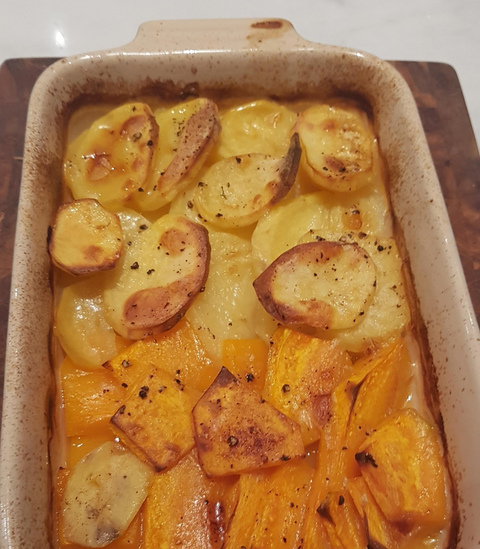
This is a delicious and easy way to make a delicious dish to go with dinner. Any root vegetable can be used; parsnips, carrots or even beetroot but if you’re using squash, cut the slices a little thicker than the potatoes as they will cook more quickly and you do not want the finished dish to be too mushy.
- 2-3 medium potatoes
- 400g chunk of pumpkin
- 3 tablespoons butter
- 1 cup chicken or vegetable stock
- Salt and freshly ground black pepper
*1 tsp thyme leaves
Preheat the oven to 200°C.
Peel the potatoes and pumpkin and slice neatly into 1.5 cm pieces.
Butter a small ovenproof dish (24cm x 16cm)
Layer the potatoes and pumpkin in 2 to 3 layers separately at each end of the dish, sprinkling the vegetables with salt and pepper, a little butter and the thyme leaves as you do this.
Dot the top with a little extra butter. You can add a layer of grated cheese on top if you wish.
Heat the stock in a saucepan and pour gently into the dish. This is best done at the edges of the dish so the salt, pepper and thyme are not disturbed.
Place in the oven for about 60 to 80 minutes until the vegetables are tender and the top is golden.
Serves 2-4 (Lovely with chicken or lamb.)
Print • ∞ Permalink • Comments
4 April 2020
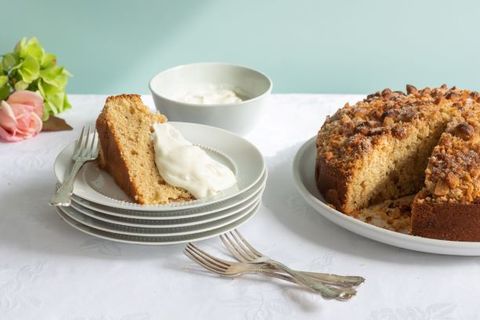
The flavours in this cake are subtle and delicious. The macadamia topping provides some nice crunch to what is a very seasonal cake as apples are at the best right now. If you haven’t got macadamias, other sweet nuts like almonds, cashews, hazelnuts, or walnuts will be equally good. Instead of the buttermilk you can use half a cup each of milk and thick plain yogurt.
- 375g plain flour
- 200g brown sugar
- 175g sugar
- 1 tbsp freshly grated nutmeg
- 1 tsp salt
- 150g butter, melted and cooled
- 2 tsp baking powder
- 1 cup buttermilk
- 2 eggs, lightly beaten
- 1 granny smith apple, peeled cored and chopped into small pieces.
- 1 cup dry roasted macadamias, chopped
- 1 tablespoon sugar mixed with 1 teaspoon ground cinnamon
Set the oven to 180°C. Grease a 24cm springform cake tin.
Place the sifted flour, sugars, nutmeg, and salt together in a large bowl. Whisk to mix well. Make a well in the centre, pour in the butter and stir until the mixture resembles coarse breadcrumbs. Set aside 3 tablespoons of the mixture to reserve for the top.
Add the baking powder, buttermilk and eggs and beat with an electric beater for a minute until smooth. Fold the chopped apple through.
Scrape this cake batter into the prepared tin, scatter the reserved crumb mixture over the top, add the nuts and the extra cinnamon/sugar mixture. Bake in the oven for 50 minutes or until the cake springs back when touched lightly and the sides shrink from the sides of the tin.
Remove to a wire rack and cool. Serve in wedges with yogurt or crème fraiche.
Print • ∞ Permalink • Comments
28 December 2018
I love the process of making pickled fish, by frying oily fish fillets and then bathing them in an aromatic brine flavoured with vegetables and spices. This sweet and sour fish dish is called escabeche, a well-loved recipe in Mediterranean and South American cuisines.
- 600g filleted fish, skin on (mullet, kahawai, gurnard etc)
- 2 tsps salt
For the pickling brine:
- 1 tbsp olive oil
- ½ onion, thinly sliced
- 2 garlic cloves, thinly sliced
- 1 stalk celery, thinly sliced
- 1 cup water
- 1 cup white wine vinegar
- 1 tbsp sugar
- 1 tsp salt
- ¼ tsp coriander seeds
- ¼ tsp fennel seeds
- ½ tsp black peppercorns
- Pinch of chilli flakes
- 1 bay leaf
- 4 sprigs thyme
For frying the fish:
- 4 tbsps olive oil
- Flour for dusting
Season the fish fillets with salt and leave to sit while you make the pickling brine.
In a deep frying pan or heavy saucepan, heat one tablespoon of oil. Add the onion, garlic and celery and cook over a very gentle heat until the vegetables are tender and soft. Add the water, vinegar, sugar and salt with all the herbs and spices. Bring this mixture to a boil, turn off the heat and let cool.
Heat the 4 tablespoons of oil in a frying pan over medium heat. Dredge the fish fillets in flour, shake off the excess and fry the fish in hot oil until browned on both sides. Remove the fish onto kitchen paper to drain and cool.
Once the fish and the brine are cool, place the fish in a glass or ceramic container, pour the brine over and leave to absorb the flavours for an hour or two. Refrigerate until needed and serve at room temperature with toast and butter.
The fish will keep for a week if refrigerated.
Serves 4 as an entrée or as a snack
Wine match: a dry sherry or an icy cold lager
Print • ∞ Permalink • Comments
2 October 2017

- 3 sheets best quality butter puff pastry, 30cm x 12cm
- 300mls cream, whipped
- 1 punnet strawberries
- ½ cup redcurrant jelly
- ½ cup strawberry jam
If using a block of puff pastry roll it out to size, place on baking sheets and allow to rest for 30 minutes before baking. If the pastry is pre-rolled you will not need to do this. Prick the surface of all the pastry with a fork.
Pre-heat the oven to 200°C. Bake the pastry until golden and crisp (around 15 minutes.) Set aside.
Whip the cream until it becomes it is lightly stiff. Remove the stalk each strawberry, and slice the fruit in half. Place the redcurrant jelly in a small pan, heating gently until it melts.
To assemble the mille feuille, take a very sharp knife and trim the edge from the pastry strips to make it sharp.
Lay the first strip on a serving platter. Spread several tablespoonfuls of jam on this, top with half the cream. Spread the second pastry sheet with more jam, and place gently on top of the first pastry sheet and cream. Add the remaining cream to this and top with the third pastry sheet.
Lay the halved strawberries on top and with a pastry brush paint the redcurrant glaze over the strawberries. It doesn’t matter if a little drizzles down.
To serve cut into slices with a very sharp knife. Serves 6.
Wine match: Asti Spumante
Print • ∞ Permalink • Comments
23 April 2016
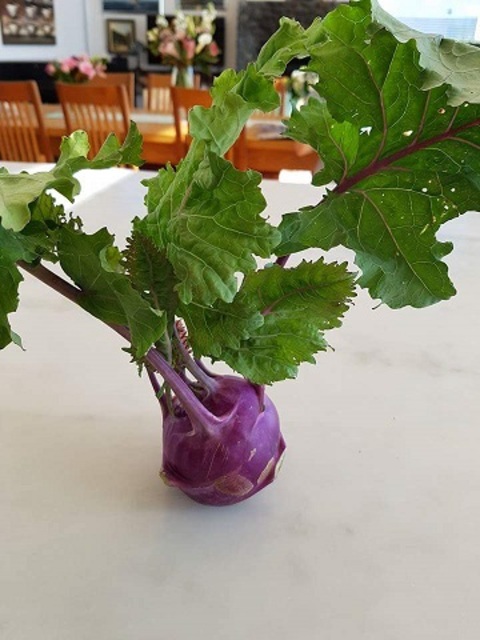
The kohlrabi is an uncommonly eaten vegetable that’s versatile and currently in season. A member of the brassica family, the leaves are edible, but the main attraction of this sputnik-like vegetable is the bulb which is in reality, the stem of the plant. It grows comfortably in most climates around New Zealand and when I enquired at my local vegetable store, the owner had no trouble sourcing both pale green and violet coloured varieties.
It is at its best when peeled and cut into thin slices or strips to be served raw in salads or as a snack with a creamy blue or goat cheese dip. Kohlrabi presented like this is sweet and juicy and ideal for children’s snacks. A five year old who tried it at my house last week declared it tasted like lettuce, but I think it tastes like a cross between broccoli and cucumber. It can also be grated for tossing into slaws or salads.
Add kohlrabi to stir-fry vegetables, soups and braises. The pieces will require about 10-15 minutes and should remain ever so slightly crisp. The flavour is not strong so a little aromatic spice such as nutmeg, ginger or cumin will boost the taste, and woody herbs like rosemary, sage or thyme pair nicely with kohlrabi.
Store the kohlrabi in the humidity controlled vegetable drawer of the refrigerator and the bulb will last for weeks, although if you plan to cook the leaves use them within a few days of harvesting.
Wild salad of kohlrabi and apple
- 1 cup walnuts
- 2 bulbs of kohlrabi
- 2 apples
- ½ cup parsley leaves
- For the vinaigrette:
1 lemon, juice and grated zest
3 tablespoons walnut oil
Salt and freshly ground black pepper
Heat the oven to 170C. Place the walnuts in a roasting pan and bake for 5-7 minutes or until the walnuts just start to colour. Remove at once.
Peel the kohlrabi and slice as thin as possible using a very sharp knife or a mandolin.
Cut the apples into quarters, remove the core and cut into 1cm sized matchstick pieces.
Chop the parsley roughly.
To make the vinaigrette, mix the lemon juice, walnut oil, salt and pepper together so they are well combined.
To assemble the salad, lay the sliced kohlrabi on a flat salad plate. Scatter the apple over this in a layer.
Top with walnuts and parsley and finally drizzle the vinaigrette over everything.
Serve to accompany grilled steak or roast pork.
Serves 4
Wine match: pinot gris
Braised kohlrabi, choko and carrots
- 1 large choko
- 2 large kohlrabi bulbs
- 2 large carrots
- ¼ cup extra virgin olive oil
- 1 tbsp ground cumin
- 2 sprigs of rosemary
- Salt and freshly ground black pepper
- Mint leaves for garnish
Peel the vegetables and cut into strips about 8cm in length and 2cm wide.
Put the olive oil in a heavy saucepan to heat. When it almost reaches smoking point add the cumin with the vegetables and the leaves of the rosemary and turn the heat down.
Toss everything well together and allow the vegetables to very slowly and gently braise in the oil. Stir occasionally and if the vegetables seem to catch on the edges, add a few spoons of water.
The vegetables will be tender and delicious after about 20-25 minutes. Season with salt and pepper, garnish with fresh mint leaves and serve hot or cold to accompany grilled chicken or grilled fish.
Serves 4
Wine match: chardonnay
Print • ∞ Permalink • Comments
15 February 2016
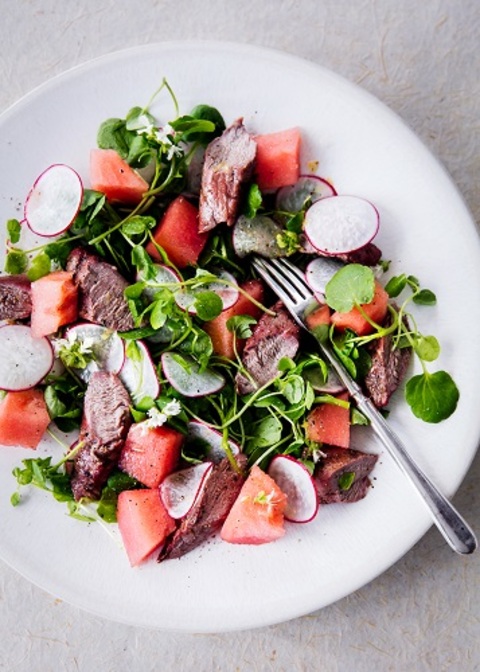
- 300g lamb fillets or tenderloins
- 2 tbsp sesame oil
- 2 lemons
- Salt and freshly ground black pepper
- 6 small firm radishes
- 2 cups baby watercress leaves
- 2 thick slices watermelon (250g)
- 1 cup small basil leaves and flowers
For the dressing:
- 1 lemon, zest and juice
- 3 tbsp grapeseed oil
- Salt and freshly ground black pepper
Trim any extra fat or sinew from the lamb.
Tip the sesame oil into a bowl and add the finely grated zest and the juice of the lemons with a little salt and freshly ground black pepper. Mix this all together and add the lamb, leaving it to marinate for up to an hour.
Meanwhile prepare the other ingredients.
Wash the radishes and cut them into paper thin slices with a very sharp knife or a Japanese mandolin.
Wash the watercress, drying it in a clean tea towel or a salad spinner. Cut any tough stalks off and discard them.
Cut the watermelon rind away and cut the flesh into nice even chunks. Remove any obvious large seeds.
Make the dressing by shaking the lemon juice, grapeseed oil and some salt and pepper together.
Heat a barbecue grill or a ridged grill pan until hot. Cook the lamb over medium heat until golden brown on both sides, but still a little springy to the touch. Allow the lamb to rest while you compose the salad. Toss the radishes, watercress, watermelon and the basil together, adding most of the dressing. Spread this on a serving platter or divide between four dinner plates.
Slice the lamb thinly and place on top of the salad, garnishing with the basil flowers. Tip the remaining dressing over the lamb and serve at once.
Serves 4
Wine match; a chilled crisp riesling
Photo by Liz Clarkson for the NZ Listener
Print • ∞ Permalink • Comments
15 February 2016
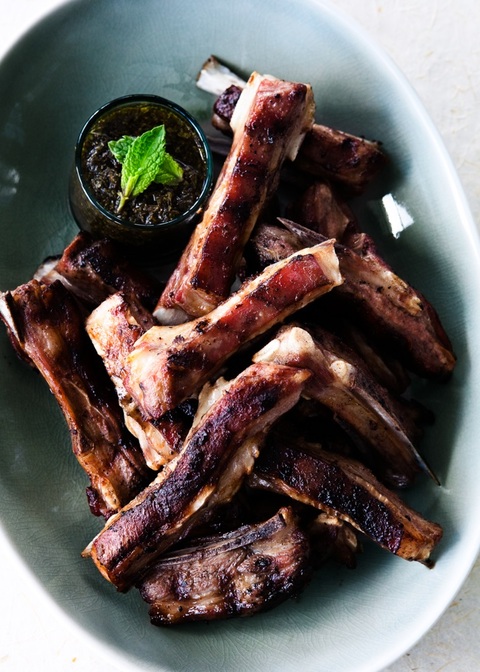
- 800 g lamb spare ribs
- 3 tbsp light soy sauce
- 2 tbsp rice wine vinegar
- 1 tbsp toasted sesame seeds
- 1 small chilli, finely sliced
- 1 tsp brown sugar
For the pickled mint sauce:
* 150 mls white wine vinegar
* 75g sugar
* 1 very large handful mint, leaves and stalks separated
Mix the soy sauce, rice wine vinegar, sesame seeds, chilli and brown sugar together and pace in a shallow tray.
Add the lamb ribs and turn them in the mixture so they are completely coated with this marinade. Leave over night or for at least an hour.
Fire up the barbecue and when hot, place the lamb ribs over the heat. Turn them frequently to make sure they do not burn. Aim to get the ribs golden brown with the edges an almost caramelly dark brown.
Remove from the heat and serve piled on a platter with the pickled mint sauce.
To make the pickled mint sauce, strip the leaves from the stalks and chop the stalks into tiny pieces. Place the white wine vinegar, sugar and the chopped stalks in a saucepan over the heat. Dissolve the sugar then bring the vinegar to the boil. Allow this to boil for about 2-3 minutes, then remove from the heat and tip into a small bowl to cool. Infuse the mixture for an hour or two, then strain it into a small jug.
Chop the mint very finely and add to the vinegar mixture. The mint will turn very dark green almost immediately due to the reaction of the vinegar but it will be delicious.
Serves 4
Wine match; pinot noir
PHOTO by Liz Clarkson for the NZ Listener
Print • ∞ Permalink • Comments








